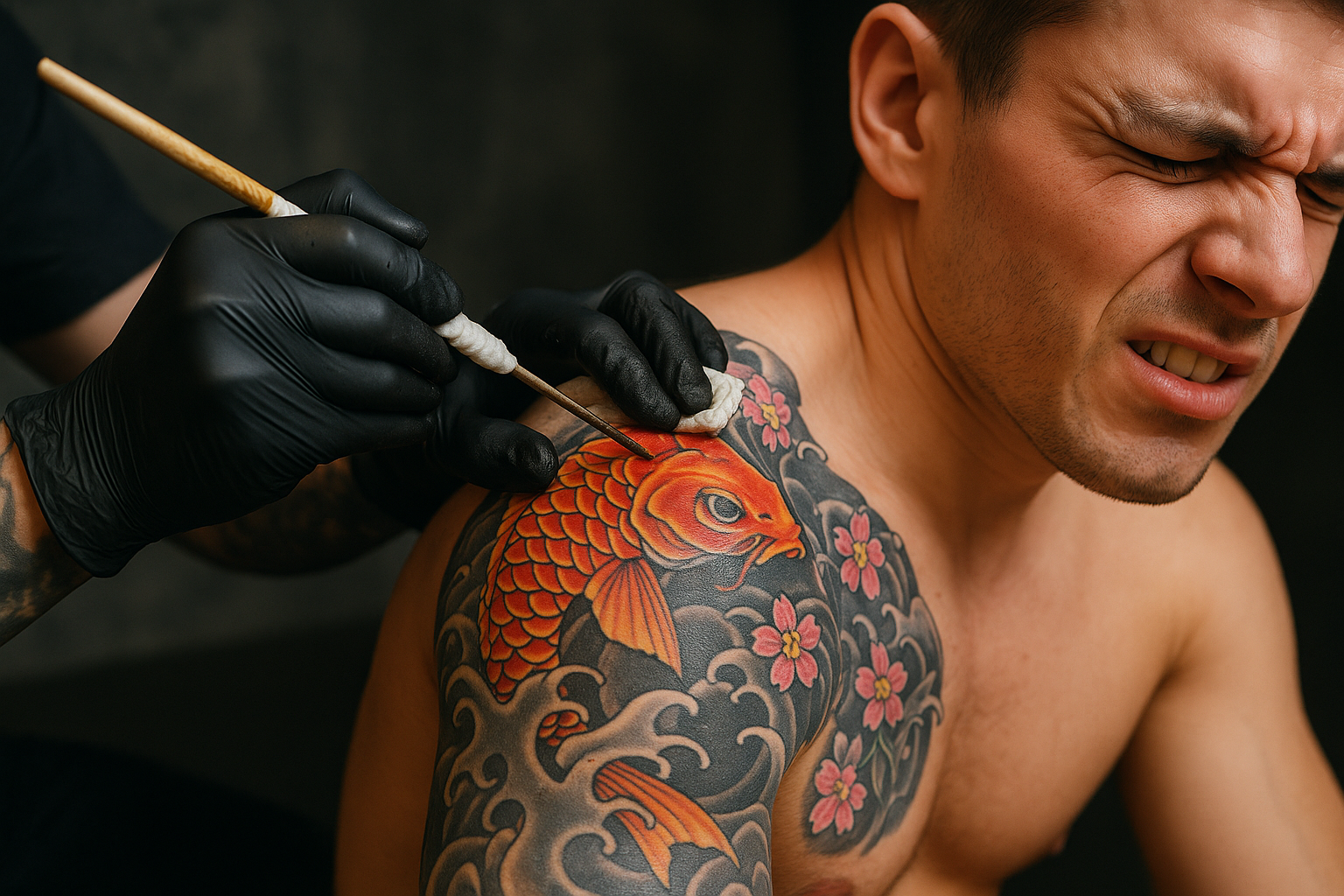Tebori — the traditional Japanese method of hand-poked tattooing — is quiet. There’s no machine buzz. No aggressive humming. Just the rhythmic sound of needles kissing skin, guided by breath, silence, and a steady hand.
But make no mistake: Tebori can hurt.
The question isn’t whether it’s painful. The question is:
What kind of pain is it — and why do people still choose it?
If you’re considering a traditional Japanese tattoo done by Tebori, here’s what you need to know about the pain, the process, and the sacred endurance woven into every tap.
🖐️ What Is Tebori, Really?
Tebori (手彫り) means “to carve by hand.” Unlike modern machines that puncture skin with rapid-fire motion, Tebori uses:
- A long handle, traditionally made of wood or metal
- Soldered needle bundles (hari)
- Manual tapping, powered entirely by the artist’s wrist and rhythm
Each needle dip is intentional. There’s no automation. Only focus, breath, and control.
💥 So… Is Tebori More Painful Than Machine Tattooing?
Yes and no. Here’s the breakdown:
💉 Machine Tattoo Pain:
- Feels sharp, hot, and fast
- Can sting like a bee swarm
- More numbing over time due to constant motion
🪵 Tebori Tattoo Pain:
- Feels deep, methodical, like tiny daggers pushed under the skin
- Slower — which can feel longer
- Some say it’s gentler, but more emotional due to the intimacy of it
“Tebori doesn’t hurt more. It just hurts differently — deeper, quieter. You’re alone with it.”
— A client of Horifune Irezumi
🧘 Tebori Pain Is Rhythmic — And That Changes Everything
Unlike the mechanical buzz of a coil machine, Tebori has a soothing, hypnotic rhythm. That rhythm allows your body to:
- Sync with the tapping
- Focus on breath
- Enter a meditative pain trance
Clients often describe it as:
- “A heartbeat in reverse”
- “Being stitched with intention”
- “Like enduring pain with eyes closed, not wide open”
This ritualistic pacing turns pain into presence.
🧪 Does Tebori Hurt Less Over Time?
Strangely, yes. While each tap is precise, the skin reacts differently.
Tebori benefits include:
- Less skin trauma (no tearing from fast-moving machines)
- Softer shading, especially for large areas
- Lower swelling and bleeding, especially on backs, ribs, and arms
The result? You may leave the session sore — but less inflamed, and you’ll often heal faster.
🔥 What Makes Tebori Pain Sacred?
In traditional Japanese tattooing, pain isn’t just tolerated — it’s honored.
Pain is part of:
- Gaman (我慢) – Enduring without complaint
- Transformation – Turning the body into art through struggle
- Spiritual Offering – Especially when tattooing deities, dragons, or protective spirits
You’re not just getting a tattoo. You’re stepping into a rite of passage.
🧠 Who Handles Tebori Pain Best?
Tebori isn’t for the flashy. It’s for the resolute.
Those who thrive in Tebori sessions:
- Practice deep breathing
- Know their why before they begin
- Treat the tattoo as a spiritual journey, not just a style choice
If you’re looking to “get it over with,” Tebori is not for you.
💬 Real Clients Say…
“Tebori was the only time I felt like the pain meant something. I cried — not from pain, but from the feeling of being carved into something real.”
— Anonymous, Tokyo
“It was slow. Intimate. Like someone writing a poem into me one line at a time.”
— Client in Frankfurt after a Horifune piece
📍 Final Answer: Yes, Tebori Hurts — But That’s the Point
Tebori hurts differently.
It hurts slowly.
It hurts with rhythm.
It hurts with meaning.
In a world of numbed-out machine buzz and shortcut symbolism, Tebori offers presence. It forces you to stay. To breathe. To feel.
It’s not pain for pain’s sake.
It’s pain that marks a threshold.
🖤 Want the Ink Without the Needles?
Not ready for the full Tebori ritual — but still want to wear the power of it?
👉 Explore our Tebori-Inspired T-Shirt Collection
From Koi to Hannya, from dragons to windbars — these designs carry the spirit of sacred pain and survival through wearable art.
📷 Image Suggestions:
- [Image 1]: Artist’s hand mid-Tebori stroke — close-up of tool touching skin
- [Image 2]: A client deep in silence, eyes closed during a backpiece session
- [Image 3]: Side-by-side of Tebori shading vs. machine shading
- [Image 4]: Japanese calligraphy for Gaman (我慢) with soft brush strokes


Leave a comment
Your email address will not be published. Required fields are marked *
You must be logged in to post a comment.